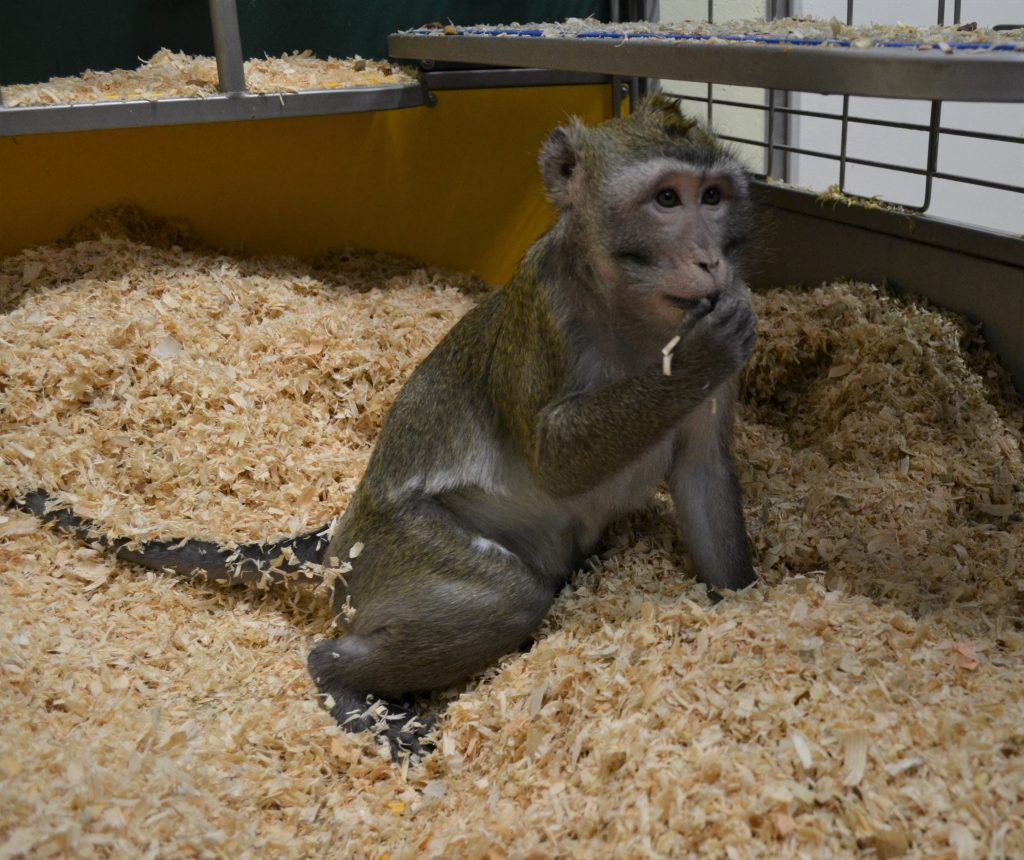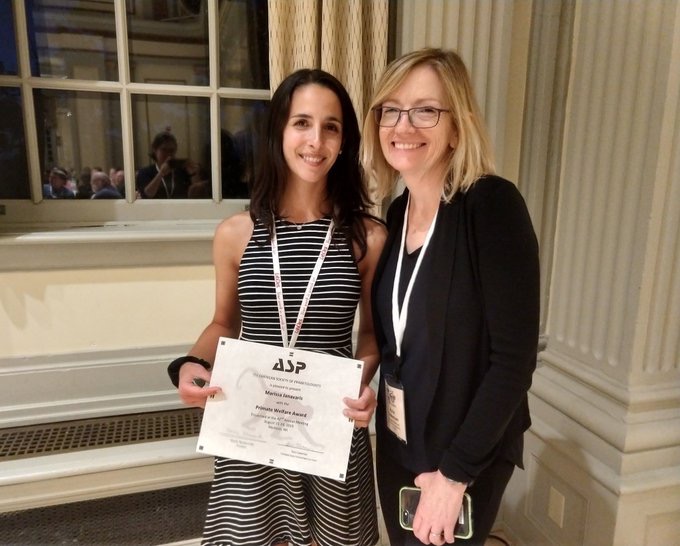
ASP Primate Welfare Award (2019): Bedding as an enrichment strategy in group-housed Mauritian cynomolgus macaques (Macaca fascicularis)
For this feature, we highlight the research of Marissa Janavaris, a member of the Behavioral Services Unit at the Oregon National Primate Research Center. Marissa and her collaborators recently conducted a study to assess the use of bedding as an enrichment strategy in two indoor-housed groups of Mauritian cynomolgus macaques. For this study, Marissa examined how the presence of bedding influenced the behavior of individual animals. She also examined whether bedding dampened sound levels in the room where the two groups were housed. Download the poster on this topic by Marissa Janavaris, Lindsay Bader, Jesper Juhl Hansen, Thóra Brynja Bödvarsdottir, Kristine Coleman*, and Paul Kievit for study details, references, and more photos. *Primate Care Committee members abstain from judging the Primate Welfare Award if he or she is a collaborator on any project submitted for award consideration.
ASP: As you are the recipient of the 2019 ASP Primate Welfare Award, can you tell us what spurred your interest in primate welfare and how your project enhances the welfare of captive nonhuman primates?
Marissa: Working at a primate research facility, I have always been interested in improving the lives of the animals I work with. Providing captive animals with opportunities to express species-typical behaviors is essential for animal well-being. Mitigating environmental stressors is also important. Bedding accomplishes both of these goals. Our study found that bedding increased foraging behavior, decreased self-grooming, and also dampened sound. The sound dampening feature is especially pertinent to indoor-housed animals, who may live in large raucous rooms where sound is amplified. Reducing sound is desirable in such conditions since excessive noise can be detrimental to animal well-being.
ASP: What are your thoughts on the tradeoff between foraging and play behavior? Since both are important species-typical behaviors and important to welfare, are there any issues with increasing foraging at the cost of decreased play (or vice versa)? Is there a way to have both increased play and increased foraging (e.g., including bedding in addition to items such as wheels and pools)?
Marissa: I don’t think there necessarily needs to be a trade-off between these two behaviors. In our study, we were not able to provide pools and/or wheels while the bedding was in place, for logistical reasons. But, the animals had chew toys at all times and were given enrichment (cardboard, pinecones, paper, etc.) during bedding weeks. They still had the choice of whether to play or forage when the bedding was present. Providing animals with choice is an important part of behavioral management. In addition, varying enrichment is a useful strategy to ensure that the animals maintain interest in different forms of enrichment. We are exploring different forms of novel enrichment that can be used in conjunction with bedding.
ASP: Having found overall positive results with pine shavings, will you be evaluating other types of bedding? Will you try bedding in other captive environments?
Marissa: We examined both pine and aspen shavings in this study and found no significant difference in the animals’ behavior or sound dampening between the two types. However, we did compare sound levels with different amounts of bedding, and found that there was a “dose dependent” effect. When we used a whole bale of bedding per pen, the sound dampening effect was greater than when we used a half bale of bedding per pen. Our center uses bedding in other group-housed environments. In the coming months we will be evaluating bedding enrichment for caged animals.
ASP: Considering your dosimeter results, would you expect to find any differences in sound dampening between the initial distribution of the bedding and when the lights are turned off?
Marissa: Bedding was added at around 3pm on Friday and left in until Monday of the second following week (10 consecutive days). The dosimeter recorded continuously over the 10-day period. No bedding was added or removed over this time. The sound dampening did not vary as the days progressed.
ASP: Is there anything else related to this project that you would like to share?
Marissa: One of the main hurdles to overcome when implementing bedding enrichment is the perception of increased husbandry cleaning time. Our husbandry unit found that although removing bedding is time consuming, overall time is saved when bedding is used because the enclosures don’t require daily washing. Utilizing different techniques and methods of cleaning can also expedite the cleaning process, such as using pressure washers. Previous studies have shown that, overall, there is no difference in husbandry cleaning time, but there is a significant water saving. For more information on work load, see the papers linked below. Hopefully with this information other centers will be more open to the idea of using bedding.
Bennett, A. J., Corcoran, C. A., Hardy, V. A., Miller, L. R., & Pierre, P. J. (2010). Multidimensional cost-benefit analysis to guide evidence-based environmental enrichment: providing bedding and foraging substrate to pen-housed monkeys. Journal of the American Association for Laboratory Animal Science, 49(5), 571-7. https://www.ncbi.nlm.nih.gov/pmc/articles/PMC2949425/
Doane, C. J., Andrews, K., Schaefer, L. J., Morelli, N., McAllister, S., & Coleman, K. (2013). Dry bedding provides cost-effective enrichment for group-housed rhesus macaques (Macaca mulatta). Journal of the American Association for Laboratory Animal Science, 52(3), 247- 52. https://www.ncbi.nlm.nih.gov/pmc/articles/PMC3690445/

